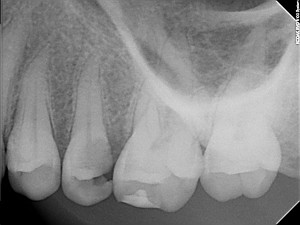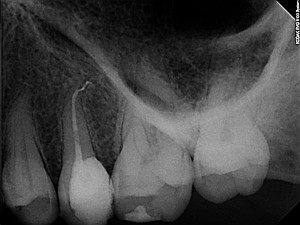Very often, teeth are referred to my practice that have extensive interproximal decay. When I first started seeing these teeth years ago, I was uncertain of where to begin. Visually it is overwhelming: You have gross decay, inflamed gingiva that may have grown into the carious lesion, no clear way to isolate the tooth and a patient who is likely in a great deal of pain.
The complete removal of caries is a hallmark of superior care for restorative dentists and endodontists. It also facilitates adequate isolation. So how is isolation achieved?
Most of us were taught in dental school to place a clamp on a rubber dam and frame, placing the rubber dam on in one piece. Others were taught to place the clamp first and then to slide the dam over the clamp and tooth. Either way, there is an emphasis on single tooth isolation. This alone represents a challenge to managing gross interproximal decay.
Use of multiple tooth isolation or a split dam technique is one way to help manage this situation. I start by resecting all visibly infected dentin and hyperplastic gingiva under the microscope. Once I am satisfied with the visual appearance of the dentin, I then turn my attention to hemostasis. Currently I am using Viscostat Clear, but I have also used Cutrol and Hemodent to control tissue bleeding and they were both effective as well. Because of it’s coloration(or lack thereof), I find Viscostat Clear less visually distracting to me. In very difficult cases, I will inject the tissue with 2% Lidocaine with 1:50000 epinephrine.
Next, I use caries finder. This is a neat little solution that stains carious tooth structure pink. I apply with a microbrush and rinse. The tissue that remains pink after rinsing is carious, although it is important to note that it will also often stain remants of the pulpal roof if any remain intact. Some people skip this step, but here is my take on it: I have been removing decay from teeth for 15 years, and even under a microscope, after removing all visible caries and refining my preparation, it is not uncommon for me to find a small area that stains pink. If I can ensure that I have completed this step that is vital to the long term success of the restoration by taking 15 seconds and applying some caries finder, what is the downside?
After ensuring that caries removal is completed, I then create my matrix. I may use an Automatrix, perhaps a Toefflemire, a sectional matrix, Cavit, Dycal, Opaldam, Copper Band or a combination of the above. Either way, I gain isolation and restore the missing marginal ridges. I often will place a cotton pellet and some Cavit in the pulp chamber to prevent restorative material from getting into the canal systems.
One thing to note is that nearly all of these teeth are going to be restored with crowns. For this reason, I am not usually attempting to close proximal contacts. If the opportunity presents itself, I will close the contact, but I don’t necessarily make an effort to do so. My goal is complete caries removal and restoration for the benefit of maintaining an isolated field during endodontic treatment and to facilitate full crown preparation after my job is done.
This is what it looks like when I’m done:
Isolation is a fundamental part of successful endodontic treatment, and complete caries removal is a part of ideal isolation.

